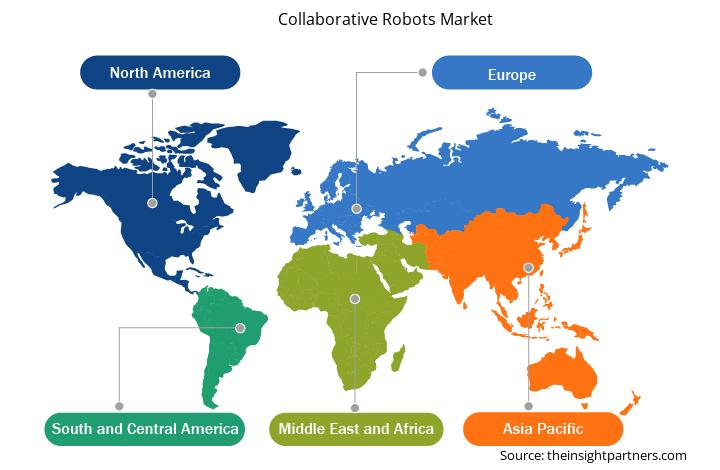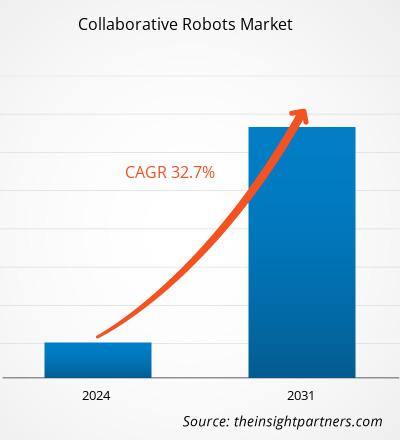من المتوقع أن يصل حجم سوق الروبوتات التعاونية إلى 14.67 مليار دولار أمريكي بحلول عام 2031، مقارنةً بـ 1.88 مليار دولار أمريكي في عام 2024. ومن المتوقع أن يسجل السوق معدل نمو سنوي مركب قدره 35.7% خلال الفترة 2025-2031. ومن المرجح أن تُحدث الروبوتات التعاونية المتنقلة اتجاهات جديدة في السوق.
تحليل سوق الروبوتات التعاونية
الروبوتات التعاونية هي فئة من روبوتات الخدمة تُستخدم في مناولة المواد والتصنيع والمختبرات. ويؤدي الطلب المتزايد في المصانع، وخاصةً في قطاع التصنيع، حيث بدأ البشر والروبوتات العمل بتناغم، إلى نمو سوق الروبوتات التعاونية . وقد مكّن ظهور الروبوتات التعاونية من توفير بيئة عمل موثوقة، حيث يمكن للبشر العمل جنبًا إلى جنب مع الروبوتات بأمان. ومن العوامل الرئيسية التي تدفع عجلة نمو السوق الدعم الحكومي لتطوير ونشر الروبوتات، والتوسع السريع في قطاع التصنيع.
نظرة عامة على سوق الروبوتات التعاونية
يشهد المشهد الصناعي تحولاً كبيراً، مدفوعاً بشكل كبير بظهور الروبوتات التعاونية - فالآلات المتطورة مصممة للعمل بأمان وفعالية جنباً إلى جنب مع البشر. تتطور هذه الروبوتات لتصبح زملاءً أذكياء في العمل، مما يعزز السلامة والإنتاجية ويدعم العمليات المستدامة. تعمل الروبوتات التعاونية بسرعات تعادل سرعة الإنسان، مما يُبسط تقييم المخاطر المتعلقة بالحركة، مما يُسهّل على المشغلين القريبين تجنب التلامس غير المقصود.
تتخذ حكومات العديد من الدول حول العالم مبادرات لدعم وتعزيز تطوير واعتماد الروبوتات في بلدانها. ومن المتوقع أن تدفع هذه المبادرات والإجراءات التي تتخذها الحكومات نمو سوق الروبوتات الصناعية عالميًا، مما يعزز الطلب على الروبوتات التعاونية. في عام 2022، استحوذت أوروبا على أكبر حصة من إيرادات سوق الروبوتات التعاونية العالمي. ومن المتوقع أن يُسهم قطاع السيارات القوي ووجود كبرى شركات تصنيع السيارات الفاخرة في أوروبا في دفع عجلة نمو سوق الروبوتات التعاونية. علاوة على ذلك، من المتوقع أن يُعزز نمو صناعة السيارات الكهربائية نمو سوق الروبوتات التعاونية.
ستحصل على تخصيص لأي تقرير - مجانًا - بما في ذلك أجزاء من هذا التقرير، أو تحليل على مستوى الدولة، وحزمة بيانات Excel، بالإضافة إلى الاستفادة من العروض والخصومات الرائعة للشركات الناشئة والجامعات
سوق الروبوتات التعاونية: رؤى استراتيجية

-
احصل على أهم اتجاهات السوق الرئيسية لهذا التقرير.ستتضمن هذه العينة المجانية تحليل البيانات، بدءًا من اتجاهات السوق وحتى التقديرات والتوقعات.
محركات وفرص سوق الروبوتات التعاونية
الدعم الحكومي لتطوير ونشر الروبوتات
تتخذ حكومات دول عديدة حول العالم مبادرات لدعم وتعزيز تطوير واعتماد الروبوتات في بلدانها. على سبيل المثال، أعلنت حكومة سنغافورة، في إطار برنامجها للتحول الصناعي، عن عدة تدابير لتسهيل الابتكار والأتمتة وتوسيع الشركات والحصول على التمويل. واتخذت حكومة الهند تدابير متنوعة لتعزيز التصنيع الذكي في الهند، بما في ذلك برنامج الحوافز المرتبطة بالإنتاج (PLI). وكمبادرة حكومية رئيسية لتعزيز التصنيع في الهند، أُطلق برنامج الحوافز المرتبطة بالإنتاج في عام 2020، وغطى 14 قطاعًا، بما في ذلك السيارات والأدوية والمنسوجات وتجهيز الأغذية والأجهزة المنزلية. علاوة على ذلك، اتخذت حكومة الصين عدة تدابير لنشر الروبوتات الصناعية في قطاع التصنيع في البلاد، بما في ذلك خطة "صنع في الصين 2025" لتطوير الصناعات عالية التقنية. كما أعلنت الحكومة عن "خطة تطوير صناعة الروبوتات" مدتها خمس سنوات لتوسيع قطاع الروبوتات الصناعية في الصين. وتقدم الحكومة إعانات وإعفاءات ضريبية كبيرة للأتمتة الصناعية. علاوة على ذلك، تشمل مبادرة الصناعة 4.0 الألمانية تطوير ونشر الروبوتات الصناعية. وقد أعلنت الحكومة عن تقديم منح نقدية غير مستردة بقيمة 78 مليون دولار أمريكي تقريبًا سنويًا لدعم معاهد البحث والشركات والهيئات الأكاديمية خلال الفترة 2016-2020 لأبحاث التفاعل بين الإنسان والتكنولوجيا. وقد أتاحت الحكومة حاليًا حوالي 300 برنامج دراسي في مجال الأتمتة والروبوتات.
أعلنت الحكومة الكورية الجنوبية عن خطة استثمارية بقيمة 2.7 مليون دولار أمريكي، تُعرف باسم الخطة الأساسية الثانية لتطوير الروبوتات الذكية، للفترة 2014-2018. وبعد انتهاء الخطة الأساسية الثانية (2014-2018)، صاغت الحكومة ونفذت الخطة الأساسية الثالثة للروبوتات الذكية (2019-2023).
التوسع السريع في صناعة التصنيع
شهد المشهد الصناعي تطورًا هائلاً في الآونة الأخيرة، حيث لعبت الروبوتات التعاونية دورًا رائدًا في إحداث تغييرات جوهرية. فعلى عكس الروبوتات التقليدية، صُممت الروبوتات التعاونية للعمل جنبًا إلى جنب مع البشر، وعادةً ما تتضمن برمجتها إجراءات سلامة تتطلب تعاونًا بشريًا، مما يحد من قدرتها على العمل بشكل مستقل. ومع ذلك، تُحقق الروبوتات التعاونية مكاسب إنتاجية كبيرة، مع تحسين سلامة مكان العمل، مما يتيح عمليات أكثر مرونة وفعالية من حيث التكلفة. وقد أصبحت مكونات أساسية في الصناعات الحديثة، حيث تجاوز نطاقها التصنيع ليشمل الخدمات اللوجستية ومرافق الرعاية الصحية حول العالم.
في قطاع التصنيع، تُستخدم الروبوتات التعاونية على نطاق واسع في مهام التجميع واللحام وصيانة الآلات والتعبئة والتغليف أو التكديس على المنصات. قدرتها على أداء عمليات متكررة ودقيقة تُحسّن جودة المنتج وتُقلل من إرهاق الموظفين. من خلال أتمتة المهام الروتينية، تُمكّن الروبوتات التعاونية العاملين من التركيز على الأنشطة ذات القيمة الأعلى، مما يُحسّن الإنتاجية والكفاءة وسلامة مكان العمل في جميع عمليات التصنيع. يشهد قطاع التصنيع العالمي توسعًا سريعًا، مع تزايد الاستثمارات في مصانع التصنيع في مناطق جديدة. يُشجع هذا التوسع على الابتكارات التكنولوجية لتعزيز إنتاجية المصانع، والحفاظ على التفوق على العملاء، واكتساب ميزة تنافسية. وبالتالي، يُعزز التوسع السريع في قطاع التصنيع الطلب على الروبوتات التعاونية عالميًا.
تحليل تجزئة تقرير سوق الروبوتات التعاونية
القطاعات الرئيسية التي ساهمت في اشتقاق تحليل سوق الروبوتات التعاونية هي الحمولة، والتطبيق، والنوع، وصناعة المستخدم النهائي، والوظائف.
- بناءً على الحمولة، يُقسّم السوق إلى فئات تتراوح حمولتها بين 5 و10 كجم، وحتى 5 كجم، وأكثر من 10 كجم. وقد استحوذت فئة حمولتها بين 5 و10 كجم على أكبر حصة سوقية في عام 2024.
- بناءً على التطبيق، يُصنف السوق إلى: التجميع، والالتقاط والوضع، ومناولة المواد، واختبار الجودة، وصيانة الآلات، واللحام، والتغليف، وغيرها. وقد استحوذ قطاع التجميع على أكبر حصة سوقية في عام ٢٠٢٤.
- يُقسّم السوق، حسب نوعه، إلى أذرع آلية، وبنادق لحام، ومقابض، وغيرها. وقد استحوذ قطاع الأذرع الآلية على الحصة السوقية الأكبر في عام ٢٠٢٤.
- بحسب قطاع المستخدم النهائي، يُقسّم السوق إلى قطاعات السيارات، والإلكترونيات، والمعادن والآلات، والأغذية والمشروبات، والخدمات اللوجستية، والأدوية، وغيرها. وسيُهيمن قطاع السيارات على السوق في عام ٢٠٢٤.
- من حيث الوظيفة، يُقسّم السوق إلى روبوتات ثابتة وروبوتات متحركة. وسيُهيمن قطاع الروبوتات الثابتة على السوق بحلول عام ٢٠٢٤.
تحليل حصة سوق الروبوتات التعاونية حسب المنطقة الجغرافية
ينقسم النطاق الجغرافي لتقرير سوق الروبوتات التعاونية بشكل أساسي إلى خمس مناطق: أمريكا الشمالية، ومنطقة آسيا والمحيط الهادئ، وأوروبا، والشرق الأوسط وأفريقيا، وأمريكا الجنوبية والوسطى.
استحوذت منطقة آسيا والمحيط الهادئ على حصة سوقية كبيرة للروبوتات التعاونية في عام 2024. وتضم المنطقة العديد من الدول النامية التي تشهد نموًا ملحوظًا في قطاعها الصناعي. وقد أصبحت المنطقة مركزًا صناعيًا عالميًا بفضل تنوع الصناعات التحويلية فيها. وبينما تحولت الصين إلى مركز للصناعات التحويلية عالية المهارة، تجذب الاقتصادات الناشئة، مثل الهند وكوريا الجنوبية وتايوان وفيتنام، بشكل متزايد الشركات التي تسعى إلى نقل عمليات التصنيع التي تتطلب مهارات منخفضة ومتوسطة. تقدم هذه الدول تكاليف عمالة تنافسية، وتشجع بنشاط الاستثمار الأجنبي المباشر من خلال مبادرات حكومية داعمة. ومع ذلك، لترسيخ مكانتها كوجهة رائدة للتصنيع في المنطقة، يجب على هذه الدول مواجهة تحديات مثل نقص العمالة الماهرة، وانخفاض مستويات الإنتاجية، وضعف البنية التحتية.
تُقدّم حكومات الاقتصادات النامية في منطقة آسيا والمحيط الهادئ تخفيضات ضريبية وأموالًا ودعمًا ماليًا وغيرها من أشكال الدعم لجذب شركات التصنيع لإنشاء مصانعها في هذه البلدان. علاوةً على ذلك، أطلقت العديد من الحكومات مبادرات مثل "صنع في الصين 2025" و"صنع في الهند". ومع ذلك، تشهد الصين، أكبر مركز صناعي، ارتفاعًا في تكلفة العمالة بسبب شيخوخة السكان. وقد دفع هذا شركات التصنيع إلى البحث عن استثمارات في دول جنوب شرق آسيا. ومن العوامل التي تجذب شركات التصنيع إلى هذه الدول تحسّن البنية التحتية، وارتفاع الاستهلاك المحلي، وانخفاض التكاليف.
الصين هي أكبر مُصنّع لسيارات الركاب في العالم. اليابان والهند وكوريا الجنوبية من بين الدول الرئيسية الأخرى في تصنيع المركبات في منطقة آسيا والمحيط الهادئ. إلى جانب صناعة السيارات، تُوظّف العديد من الصناعات الأخرى في الصين الروبوتات التعاونية؛ على سبيل المثال، في شركة شيامن رانر الصناعية، إحدى أكبر مُصنّعي إكسسوارات الحمامات في الصين، تم استخدام 64 روبوتًا من شركة يونيفرسال روبوتس على خط الإنتاج لأداء مهام مُتنوعة، بدءًا من العناية بآلات الحقن والقولبة وصولًا إلى تجميع المنتجات.
رؤى إقليمية حول سوق الروبوتات التعاونية
قام محللو شركة إنسايت بارتنرز بشرح شامل للاتجاهات الإقليمية والعوامل المؤثرة في سوق الروبوتات التعاونية خلال فترة التوقعات. ويناقش هذا القسم أيضًا قطاعات سوق الروبوتات التعاونية ونطاقها الجغرافي في أمريكا الشمالية، وأوروبا، وآسيا والمحيط الهادئ، والشرق الأوسط وأفريقيا، وأمريكا الجنوبية والوسطى.

- احصل على البيانات الإقليمية المحددة لسوق الروبوتات التعاونية
نطاق تقرير سوق الروبوتات التعاونية
| سمة التقرير | تفاصيل |
|---|---|
| حجم السوق في عام 2025 | 1.88 مليار دولار أمريكي |
| حجم السوق بحلول عام 2031 | 14.67 مليار دولار أمريكي |
| معدل النمو السنوي المركب العالمي (2025 - 2031) | 35.7% |
| البيانات التاريخية | 2021-2023 |
| فترة التنبؤ | 2025-2031 |
| القطاعات المغطاة |
حسب الحمولة
|
| المناطق والدول المغطاة |
أمريكا الشمالية
|
| قادة السوق وملفات تعريف الشركات الرئيسية |
|
كثافة اللاعبين في سوق الروبوتات التعاونية: فهم تأثيرها على ديناميكيات الأعمال
يشهد سوق الروبوتات التعاونية نموًا سريعًا، مدفوعًا بتزايد طلب المستخدمين النهائيين نتيجةً لعوامل مثل تطور تفضيلات المستهلكين، والتقدم التكنولوجي، وزيادة الوعي بمزايا المنتج. ومع تزايد الطلب، تعمل الشركات على توسيع عروضها، والابتكار لتلبية احتياجات المستهلكين، والاستفادة من الاتجاهات الناشئة، مما يُعزز نمو السوق.
تشير كثافة اللاعبين في السوق إلى توزيع الشركات أو المؤسسات العاملة في سوق أو قطاع معين. وتشير إلى عدد المنافسين (اللاعبين في السوق) الموجودين في سوق معين نسبةً إلى حجمه أو قيمته السوقية الإجمالية.
الشركات الرئيسية العاملة في سوق الروبوتات التعاونية هي:
- شركة كوكا ايه جي
- شركة ياسكاوا أمريكا
- شركة أوبو (بكين) لتكنولوجيا الروبوتات المحدودة
- شركة دوسان للروبوتات
- شركة فانوك
- شركة أيه بي بي المحدودة
إخلاء المسؤولية : الشركات المذكورة أعلاه ليست مرتبة بأي ترتيب معين.

- احصل على نظرة عامة على أهم اللاعبين الرئيسيين في سوق الروبوتات التعاونية
أخبار سوق الروبوتات التعاونية والتطورات الأخيرة
يُقيّم سوق الروبوتات التعاونية بجمع بيانات نوعية وكمية بعد البحث الأولي والثانوي، والتي تشمل منشورات الشركات المهمة، وبيانات الجمعيات، وقواعد البيانات. فيما يلي بعض التطورات في سوق الروبوتات التعاونية:
- أعلنت شركة OMRON عن توفر روبوتات OMRON TM S التعاونية، المصممة لتطبيقات متنوعة في قطاعات متعددة. تتميز هذه الروبوتات التعاونية بأجهزة متطورة، ومزايا أمان وشهادات اعتماد أكثر، وقدرات تكوين متطورة، مما يجعلها أسهل استخدامًا من أي وقت مضى. (المصدر: OMRON، بيان صحفي، سبتمبر 2024)
- أصدرت مجموعة TÜV Rheinland، وهي منظمة مستقلة رائدة عالميًا في مجال الاختبار والتفتيش وإصدار الشهادات، شهادة CE لتوجيه الآلات وشهادة الامتثال للسلامة الوظيفية لمنتجات ESS (حلول سلامة ESTUN) لشركة ESTUN Automation Co., Ltd. ويشير هذا إلى التقدم السريع الذي أحرزته ESTUN في بناء نظام شامل لمنتجات السلامة الوظيفية للروبوتات. ولا تُظهر هذه الشهادة فقط قوة ESTUN الابتكارية ومستواها المهني في مجال تكنولوجيا الروبوتات، بل تعكس أيضًا رقابة صارمة والتزامًا بسلامة وجودة المنتجات، وستعزز جودة خدمات ESTUN وكفاءتها في السوق العالمية. (المصدر: ESTUN Robotics، بيان صحفي، أبريل 2024)
تغطية تقرير سوق الروبوتات التعاونية والنتائج المتوقعة
يقدم تقرير "حجم سوق الروبوتات التعاونية والتوقعات (2021-2031)" تحليلاً مفصلاً للسوق يغطي المجالات التالية:
- حجم سوق الروبوتات التعاونية وتوقعاتها على المستويات العالمية والإقليمية والوطنية لجميع قطاعات السوق الرئيسية التي يغطيها النطاق
- اتجاهات سوق الروبوتات التعاونية، بالإضافة إلى ديناميكيات السوق مثل المحركات والقيود والفرص الرئيسية
- تحليل مفصل لـ PEST و SWOT
- تحليل سوق الروبوتات التعاونية الذي يغطي اتجاهات السوق الرئيسية والإطار العالمي والإقليمي والجهات الفاعلة الرئيسية واللوائح والتطورات الأخيرة في السوق
- تحليل المشهد الصناعي والمنافسة الذي يغطي تركيز السوق، وتحليل خريطة الحرارة، واللاعبين البارزين، والتطورات الأخيرة لسوق الروبوتات التعاونية
- ملفات تعريف الشركة التفصيلية
- التحليل التاريخي (سنتان)، سنة الأساس، التوقعات (7 سنوات) مع معدل النمو السنوي المركب
- تحليل PEST و SWOT
- حجم السوق والقيمة / الحجم - عالمي، إقليمي، بلد
- الصناعة والمنافسة
- مجموعة بيانات إكسل
التقارير الحديثة
شهادات العملاء
سبب الشراء
- اتخاذ قرارات مدروسة
- فهم ديناميكيات السوق
- تحليل المنافسة
- رؤى العملاء
- توقعات السوق
- تخفيف المخاطر
- التخطيط الاستراتيجي
- مبررات الاستثمار
- تحديد الأسواق الناشئة
- تحسين استراتيجيات التسويق
- تعزيز الكفاءة التشغيلية
- مواكبة التوجهات التنظيمية






















 احصل على عينة مجانية ل - سوق الروبوتات التعاونية
احصل على عينة مجانية ل - سوق الروبوتات التعاونية